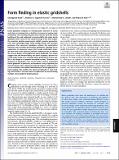Form finding in elastic gridshells
Author(s)
Sageman-Furnas, Andrew O.; Baek, Changyeob; Jawed, Mohammad K.; Reis, Pedro Miguel
Download75.full.pdf (2.440Mb)
PUBLISHER_POLICY
Publisher Policy
Article is made available in accordance with the publisher's policy and may be subject to US copyright law. Please refer to the publisher's site for terms of use.
Terms of use
Metadata
Show full item recordAbstract
Elastic gridshells comprise an initially planar network of elastic rods that are actuated into a shell-like structure by loading their extremities. The resulting actuated form derives from the elastic buckling of the rods subjected to inextensibility. We study elastic gridshells with a focus on the rational design of the final shapes. Our precision desktop experiments exhibit complex geometries, even from seemingly simple initial configurations and actuation processes. The numerical simulations capture this nonintuitive behavior with excellent quantitative agreement, allowing for an exploration of parameter space that reveals multistable states. We then turn to the theory of smooth Chebyshev nets to address the inverse design of hemispherical elastic gridshells. The results suggest that rod inextensibility, not elastic response, dictates the zeroth-order shape of an actuated elastic gridshell. As it turns out, this is the shape of a common household strainer. Therefore, the geometry of Chebyshev nets can be further used to understand elastic gridshells. In particular, we introduce a way to quantify the intrinsic shape of the empty, but enclosed regions, which we then use to rationalize the nonlocal deformation of elastic gridshells to point loading. This justifies the observed difficulty in form finding. Nevertheless, we close with an exploration of concatenating multiple elastic gridshell building blocks.
Date issued
2017-12Department
Massachusetts Institute of Technology. Department of Civil and Environmental Engineering; Massachusetts Institute of Technology. Department of Mechanical EngineeringJournal
Proceedings of the National Academy of Sciences
Publisher
National Academy of Sciences (U.S.)
Citation
Baek, Changyeob et al. “Form Finding in Elastic Gridshells.” Proceedings of the National Academy of Sciences 115, 1 (December 2017): 75–80 © 2017 National Academy of Science
Version: Final published version
ISSN
0027-8424
1091-6490